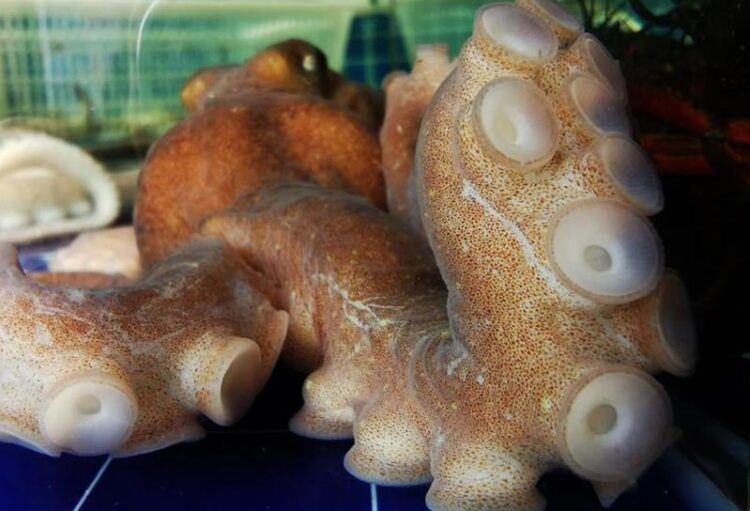Octopus inspires new suction mechanism for robots

Octopus suckers
Credit: Tianqi Yue
A new robotic suction cup which can grasp rough, curved and heavy stone, has been developed by scientists at the University of Bristol.
The team, based at Bristol Robotics Laboratory, studied the structures of octopus biological suckers, which have superb adaptive suction abilities enabling them to anchor to rock.
In their findings, published in the journal PNAS today, the researchers show how they were able create a multi-layer soft structure and an artificial fluidic system to mimic the musculature and mucus structures of biological suckers.
Image of suction cup grasping a stone. Credit: Tianqi Yue
Suction is a highly evolved biological adhesion strategy for soft-body organisms to achieve strong grasping on various objects. Biological suckers can adaptively attach to dry complex surfaces such as rocks and shells, which are extremely challenging for current artificial suction cups. Although the adaptive suction of biological suckers is believed to be the result of their soft body’s mechanical deformation, some studies imply that in-sucker mucus secretion may be another critical factor in helping attach to complex surfaces, thanks to its high viscosity.
Lead author Tianqi Yue explained: “The most important development is that we successfully demonstrated the effectiveness of the combination of mechanical conformation – the use of soft materials to conform to surface shape, and liquid seal – the spread of water onto the contacting surface for improving the suction adaptability on complex surfaces. This may also be the secret behind biological organisms ability to achieve adaptive suction.”
Their multi-scale suction mechanism is an organic combination of mechanical conformation and regulated water seal. Multi-layer soft materials first generate a rough mechanical conformation to the substrate, reducing leaking apertures to just micrometres. The remaining micron-sized apertures are then sealed by regulated water secretion from an artificial fluidic system based on the physical model, thereby the suction cup achieves long suction longevity on diverse surfaces but with minimal overflow.
Tianqi added: “We believe the presented multi-scale adaptive suction mechanism is a powerful new adaptive suction strategy which may be instrumental in the development of versatile soft adhesion.
“Current industrial solutions use always-on air pumps to actively generate the suction however, these are noisy and waste energy.
“With no need for a pump, it is well known that many natural organisms with suckers, including octopuses, some fishes such as suckerfish and remoras, leeches, gastropods and echinoderms, can maintain their superb adaptive suction on complex surfaces by exploiting their soft body structures.”
The findings have great potential for industrial applications, such as providing a next-generation robotic gripper for grasping a variety of irregular objects.
The team now plan to build a more intelligent suction cup, by embedding sensors into the suction cup to regulate suction cup’s behaviour.
Paper:
‘Bioinspired multiscale adaptive suction on complex dry surfaces enhanced by regulated water secretion’ by Tianqi Yue, Weiyong Si, Alex Keller, Chenguang Yang, Hermes Bloomfield-Gadêlha and Jonathan Rossiter in PNAS.
Journal: Proceedings of the National Academy of Sciences
Method of Research: Experimental study
Subject of Research: Not applicable
Media Contact
Laura Thomas
University of Bristol
lauram.thomas@bristol.ac.uk
Office: 07-977-983-814
All latest news from the category: Power and Electrical Engineering
This topic covers issues related to energy generation, conversion, transportation and consumption and how the industry is addressing the challenge of energy efficiency in general.
innovations-report provides in-depth and informative reports and articles on subjects ranging from wind energy, fuel cell technology, solar energy, geothermal energy, petroleum, gas, nuclear engineering, alternative energy and energy efficiency to fusion, hydrogen and superconductor technologies.
Newest articles
Faster, more energy-efficient way to manufacture an industrially important chemical
Zirconium combined with silicon nitride enhances the conversion of propane — present in natural gas — needed to create in-demand plastic, polypropylene. Polypropylene is a common type of plastic found…

Energy planning in Ghana as a role model for the world
Improving the resilience of energy systems in the Global South. What criteria should we use to better plan for resilient energy systems? How do socio-economic, technical and climate change related…

Artificial blood vessels could improve heart bypass outcomes
Artificial blood vessels could improve heart bypass outcomes. 3D-printed blood vessels, which closely mimic the properties of human veins, could transform the treatment of cardiovascular diseases. Strong, flexible, gel-like tubes…





















